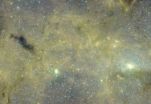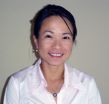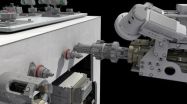(Press-News.org) PASADENA, Calif.—It's the mystery of the curiously dense cloud. And astronomers at the California Institute of Technology (Caltech) are on the case.
Near the crowded galactic center, where billowing clouds of gas and dust cloak a supermassive black hole three million times as massive as the sun—a black hole whose gravity is strong enough to grip stars that are whipping around it at thousands of kilometers per second—one particular cloud has baffled astronomers. Indeed, the cloud, dubbed G0.253+0.016, defies the rules of star formation.
In infrared images of the galactic center, the cloud—which is 30 light-years long—appears as a bean-shaped silhouette against a bright backdrop of dust and gas glowing in infrared light. The cloud's darkness means it is dense enough to block light.
According to conventional wisdom, clouds of gas that are this dense should clump up to create pockets of even denser material that collapse due to their own gravity and eventually form stars. One such gaseous region famed for its prodigious star formation is the Orion Nebula. And yet, although the galactic-center cloud is 25 times denser than Orion, only a few stars are being born there—and even then, they are small. In fact, the Caltech astronomers say, its star-formation rate is 45 times lower than what astronomers might expect from such a dense cloud.
"It's a very dense cloud and it doesn't form any massive stars—which is very weird," says Jens Kauffmann, a senior postdoctoral scholar at Caltech.
In a series of new observations, Kauffmann, along with Caltech postdoctoral scholar Thushara Pillai and Qizhou Zhang of the Harvard-Smithsonian Center for Astrophysics, have discovered why: not only does it lack the necessary clumps of denser gas, but the cloud itself is swirling so fast that it can't settle down to collapse into stars.
The results, which show that star formation may be more complex than previously thought and that the presence of dense gas does not automatically imply a region where such formation occurs, may help astronomers better understand the process.
The team presented their findings—which have been recently accepted for publication in the Astrophysical Journal Letters—at the 221st meeting of the American Astronomical Society in Long Beach, California.
To determine whether the cloud contained clumps of denser gas, called dense cores, the team used the Submillimeter Array (SMA), a collection of eight radio telescopes on top of Mauna Kea in Hawaii. In one possible scenario, the cloud does contain these dense cores, which are roughly 10 times denser than the rest of the cloud, but strong magnetic fields or turbulence in the cloud disturbs them, thus preventing them from turning into full-fledged stars.
However, by observing the dust mixed into the cloud's gas and measuring N2H+—an ion that can only exist in regions of high density and is therefore a marker of very dense gas—the astronomers found hardly any dense cores. "That was very surprising," Pillai says. "We expected to see a lot more dense gas."
Next, the astronomers wanted to see if the cloud is being held together by its own gravity—or if it is swirling so fast that it is on the verge of flying apart. If it is churning too fast, it can't form stars. Using the Combined Array for Research in Millimeter-wave Astronomy (CARMA)—a collection of 23 radio telescopes in eastern California run by a consortium of institutions, of which Caltech is a member—the astronomers measured the velocities of the gas in the cloud and found that it is up to 10 times faster than is normally seen in similar clouds. This particular cloud, the astronomers found, was barely held together by its own gravity. In fact, it may soon fly apart.
The CARMA data revealed yet another surprise: the cloud is full of silicon monoxide (SiO), which is only present in clouds where streaming gas collides with and smashes apart dust grains, releasing the molecule. Typically, clouds only contain a smattering of the compound. It is usually observed when gas flowing out from young stars plows back into the cloud from which the stars were born. But the extensive amount of SiO in the galactic-center cloud suggests that it may consist of two colliding clouds, whose impact sends shockwaves throughout the galactic-center cloud. "To see such shocks on such large scales is very surprising," Pillai says.
G0.253+0.016 may eventually be able to make stars, but to do so, the researchers say, it will need to settle down so that it can build dense cores, a process that could take several hundred thousand years. But during that time, the cloud will have traveled a great distance around the galactic center, and it may crash into other clouds or be yanked apart by the gravitational pull of the galactic center. In such a disruptive environment, the cloud may never give birth to stars.
The findings also further muddle another mystery of the galactic center: the presence of young star clusters. The Arches Cluster, for example, contains about 150 bright, massive, young stars, which only live for a few million years. Because that is too short an amount of time for the stars to have formed elsewhere and migrated to the galactic center, they must have formed at their current location. Astronomers thought this occurred in dense clouds like G0.253+0.016. If not there, then where do the clusters come from?
The astronomers' next step is to study similarly dense clouds around the galactic center. The team has just completed a new survey with the SMA and is continuing another with CARMA. This year, they will also use the Atacama Large Millimeter Array (ALMA) in Chile's Atacama Desert—the largest and most advanced millimeter telescope in the world—to continue their research program, which the ALMA proposal committee has rated a top priority for 2013.
The title of the Astrophysical Journal Letters paper is, "The galactic center cloud G0.253+0.016: a massive dense cloud with low star formation potential." This research was supported by the National Science Foundation.
INFORMATION:
Written by Marcus Woo
A cloudy mystery
A puzzling cloud near the galaxy's center may hold clues to how stars are born
2013-01-11
ELSE PRESS RELEASES FROM THIS DATE:
Unemployment benefits not sought by jobless
2013-01-11
Montreal, January 9, 2013 – Employment insurance is a vital safety net for the unemployed across North America, yet some take advantage of the system. Recent headlines have made much of a recent report from the U.S. Department of Labor that 11 per cent of all unemployment benefits were overpaid between 2009-11. But new research from Concordia University proves that uncollected benefits represent a much larger dollar figure than overpayments.
In a study commissioned by the St. Louis Federal Reserve Bank, Concordia economics professor David Fuller examines the U.S. unemployment ...
3-D biomimetic scaffolds support regeneration of complex tissues from stem cells
2013-01-11
New Rochelle, NY, January 10, 2013—Stem cells can be grown on biocompatible scaffolds to form complex tissues such as bone, cartilage, and muscle for repair and regeneration of damaged or diseased tissue. However, to function properly, the cells must often grow in a specific pattern or alignment. An innovative method for creating a stretched polymer scaffold that can support complex tissue architectures is described in an article in Tissue Engineering, Part C, Methods, a peer-reviewed journal from Mary Ann Liebert, Inc., publishers. The article is available on the Tissue ...
NASA sees Tropical Cyclone Narelle approaching Western Australia coast
2013-01-11
NASA's Aqua satellite looked at Cyclone Narelle in visible and infrared light to understand the behavior of the storm. NASA's MODIS and AIRS instruments provided those data, respectively, and they showed that Narelle is gaining strength as it approaches the northern coast of Western Australia.
Watches and Warnings are posted for the western coast of Western Australia over the next several days as Narelle continues to move on a southerly track, where it is expected to remain at sea, but parallel the coast.
Current Australian warnings include: a Cyclone Warning is in ...
Surgical technique spots cancer invasion with fluorescence
2013-01-11
One of the greatest challenges faced by cancer surgeons is to know exactly which tissue to remove, or not, while the patient is under anesthesia. A team of surgeons and scientists at University of California, San Diego School of Medicine have developed a new technique that will allow surgeons to identify during surgery which lymph nodes are cancerous so that healthy tissue can be saved. The findings will be published in the January 15 print edition of Cancer Research.
"This research is significant because it shows real-time intraoperative detection of cancer metastases ...
Scripps Florida scientists uncover potential drug target to block cell death in Parkinson's disease
2013-01-11
JUPITER, FL, January 10, 2013 – Oxidative stress is a primary villain in a host of diseases that range from cancer and heart failure to Alzheimer's disease, Amyotrophic Lateral Sclerosis and Parkinson's disease. Now, scientists from the Florida campus of The Scripps Research Institute (TSRI) have found that blocking the interaction of a critical enzyme may counteract the destruction of neurons associated with these neurodegenerative diseases, suggesting a potential new target for drug development.
These findings appear in the January 11, 2013 edition of The Journal of ...
NASA's robotic refueling demo set to jumpstart expanded capabilities in space
2013-01-11
In mid-January, NASA will take the next step in advancing robotic satellite-servicing technologies as it tests the Robotic Refueling Mission, or RRM aboard the International Space Station. The investigation may one day substantially impact the many satellites that deliver products Americans rely upon daily, such as weather reports, cell phones and television news.
During five days of operations, controllers from NASA and the Canadian Space Agency will use the space station's remotely operated Special Purpose Dexterous Manipulator, or Dextre, robot to simulate robotic ...
Study finds poorer outcomes for obese patients treated for lumbar disc herniation
2013-01-11
Rosemont, Ill. – While obese patients are more likely to have surgical treatment for lumbar disc herniation – a slipped or ruptured disc – than nonobese patients, obesity increases operative time, blood loss and length of hospital stay, according to new research published in the January 2013 Journal of Bone and Joint Surgery (JBJS). Overall, obese patients had poorer outcomes with surgical and nonsurgical treatments for lumbar disc herniation than nonobese patients.
The study included 854 nonobese patients with a Body Mass Index (BMI) of less than 30 kg/m², and 336 ...
Virus caught in the act of infecting a cell
2013-01-11
AUSTIN, Texas — The detailed changes in the structure of a virus as it infects an E. coli bacterium have been observed for the first time, report researchers from The University of Texas at Austin and The University of Texas Health Science Center at Houston (UT Health) Medical School this week in Science Express.
To infect a cell, a virus must be able to first find a suitable cell and then eject its genetic material into its host. This robot-like process has been observed in a virus called T7 and visualized by Ian Molineux, professor of biology at The University of Texas ...
Stem cells found to heal damaged artery in lab study
2013-01-11
Scientists at the Texas Biomedical Research Institute have for the first time demonstrated that baboon embryonic stem cells can be programmed to completely restore a severely damaged artery. These early results show promise for eventually developing stem cell therapies to restore human tissues or organs damaged by age or disease.
"We first cultured the stem cells in petri dishes under special conditions to make them differentiate into cells that are the precursors of blood vessels, and we saw that we could get them to form tubular and branching structures, similar to ...
UC Davis study deflates notion that pear-shaped bodies more healthy than apples
2013-01-11
(SACRAMENTO, Calif.) — People who are "apple-shaped" — with fat more concentrated around the abdomen — have long been considered more at risk for conditions such as heart disease and diabetes than those who are "pear-shaped" and carry weight more in the buttocks, hips and thighs.
But new research conducted at UC Davis Health System published in The Journal of Clinical Endocrinology and Metabolism provides further evidence that the protective benefits of having a pear-body shape may be more myth than reality. The journal article posted online January 10 and will appear ...
LAST 30 PRESS RELEASES:
Low daily alcohol intake linked to 50% heightened mouth cancer risk in India
American Meteorological Society announces Rick Spinrad as 2026 President-Elect
Biomass-based carbon capture spotlighted in newly released global climate webinar recording
Illuminating invisible nano pollutants: advanced bioimaging tracks the full journey of emerging nanoscale contaminants in living systems
How does age affect recovery from spinal cord injury?
Novel AI tool offers prognosis for patients with head and neck cancer
Fathers’ microplastic exposure tied to their children’s metabolic problems
Research validates laboratory model for studying high-grade serous ovarian cancer
SIR 2026 delivers transformative breakthroughs in minimally invasive medicine to improve patient care
Stem Cell Reports most downloaded papers of 2025 highlight the breadth and impact of stem cell research
Oxford-led study estimates NHS spends around 3% of its primary and secondary care budget on the health impacts of heat and cold in England
A researcher’s long quest leads to a smart composite breakthrough
Urban wild bees act as “microbial sensors” of city health.
New study finds where you live affects recovery after a hip fracture
Forecasting the impact of fully automated vehicle adoption on US road traffic injuries
Alcohol-related hospitalizations from 2016 to 2022
Semaglutide and hospitalizations in patients with obesity and established cardiovascular disease
Researchers ‘listen in’ to embryo-mother interactions during implantation using a culture system replicating the womb lining
How changing your diet could help save the world
How to make AI truly scalable and reliable for real-time traffic assignment?
Beyond fragmented markets: A new framework for efficient and stable ride-pooling
Can shape priors make road perception more reliable for autonomous driving?
AI tracks nearly 100 years of aging research, revealing key trends and gaps
Innovative techniques enable Italy’s first imaging of individual trapped atoms
KIER successfully develops Korea-made “calibration thermoelectric module” for measuring thermoelectric device performance
Diversifying US Midwest farming for stability and resilience
Emphasizing immigrants’ deservingness shifts attitudes
Japanese eels, climate change, and river temperature
Pusan National University researchers discover faster, smarter heat treatment for lightweight magnesium metals
China’s 2024 Gastroenterology Report: marked progress in endoscopy quality and disease management
[Press-News.org] A cloudy mysteryA puzzling cloud near the galaxy's center may hold clues to how stars are born






